Bhushan B. Handbook of Micro/Nano Tribology, Second Edition
Подождите немного. Документ загружается.

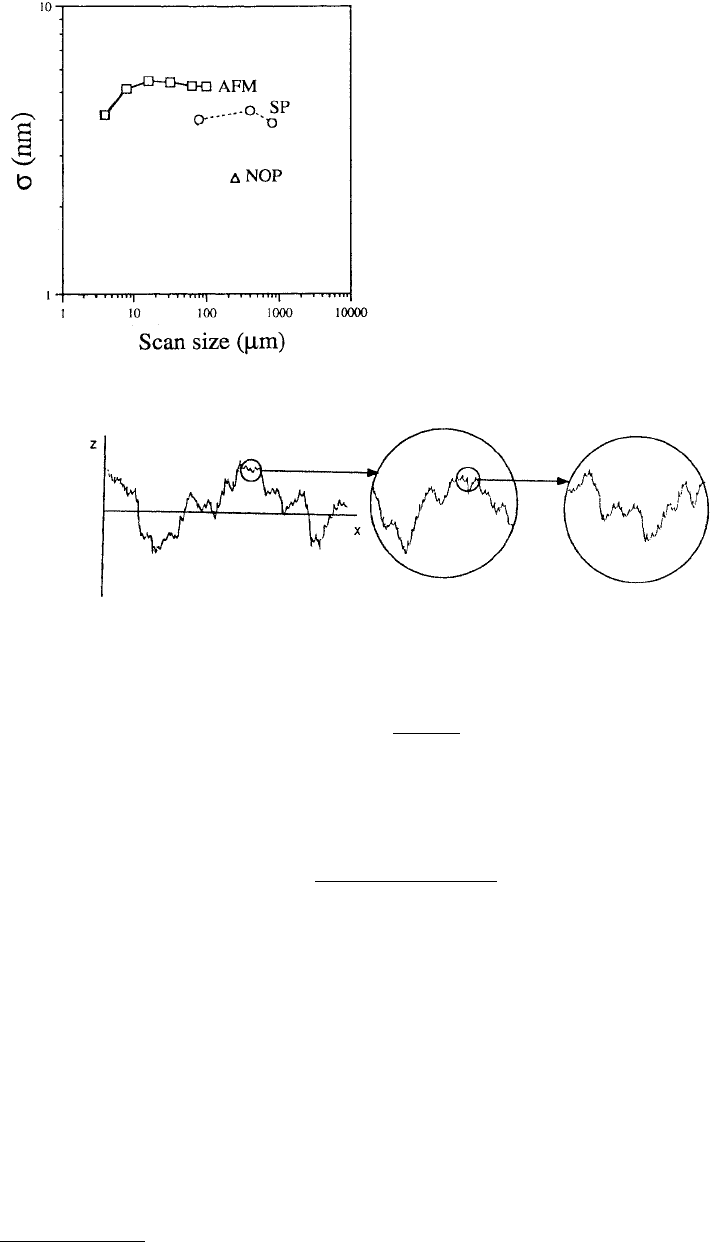
© 1999 by CRC Press LLC
(14.2a)
and
(14.2b)
The fractal analysis allows the characterization of surface roughness by two parameters
D
and
C
, which
are instrument independent and unique for each surface.
D
(ranging from 1 to 2 for surface profile)
primarily relates to relative power of the frequency contents and
C
to the amplitude of all frequencies.
η
is the lateral resolution of the measuring instrument,
τ
is the size of the increment (distance), and
ω
is the frequency of the roughness. Note that if
S
(
τ
) or
P
(
ω
) are plotted as a function of
τ
or
ω
, respectively,
on a log–log plot, then the power law behavior would result in a straight line. The slope of line is related
to
D
and the location of the spectrum along the power axis is related to
C
.
Figure 14.6 presents the structure function of a thin-film rigid disk measured using AFM, noncontact
optical profiler (NOP), and stylus profiler (SP). A horizontal shift in the structure functions from one
scan to another arises from the change in the lateral resolution.
D
and
C
values for various scan lengths
are listed in Table 14.1. We note that fractal dimension of the various scans is fairly constant (1.26 to
1.33); however, C increases/decreases monotonically with
σ
for the AFM data. The error in estimation
FIGURE 14.4
Scale dependence of standard deviation of
surface heights for a glass–ceramic disk, measured using
AFM, SP, and NOP.
FIGURE 14.5
Qualitative description of statistical self-affinity for a surface profile.
P
c
D
D
ω
η
ω
()
=
−
()
−
()
1
23
52
,
c
DD
C
1
52 2
2
=
−
()
π−
()
[]
π
Γ sin
.
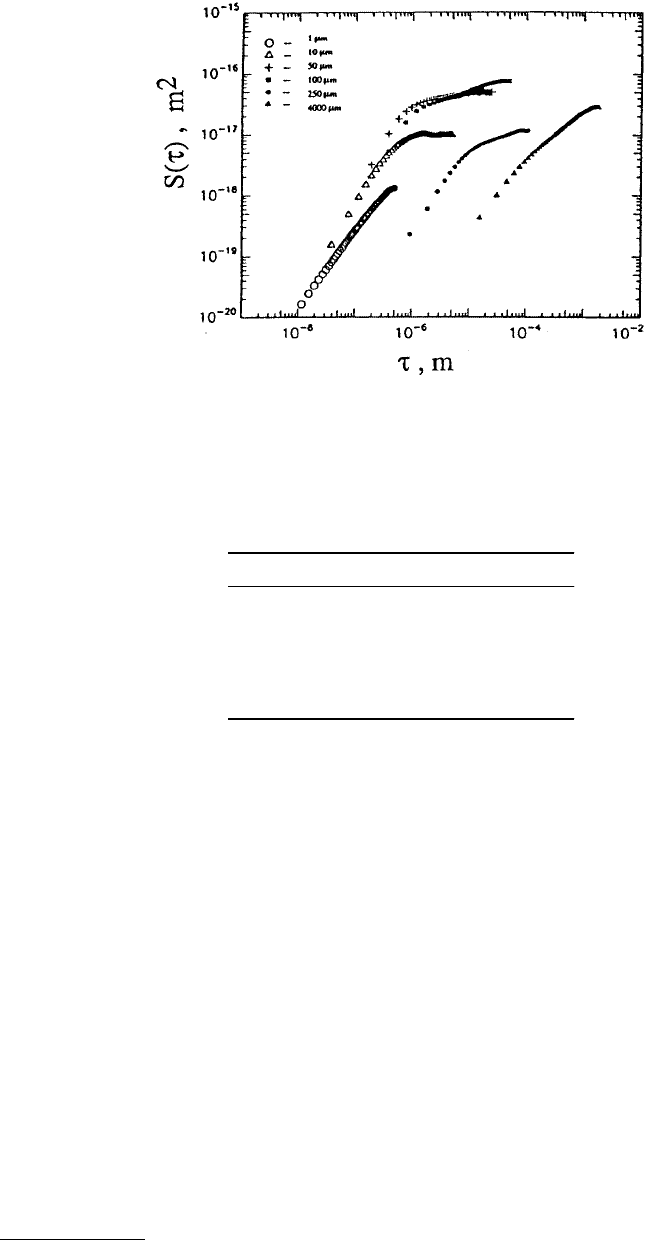
© 1999 by CRC Press LLC
of
η
is believed to be responsible for variation in
C
. These data show that the disk surface follows a fractal
structure for three decades of length scales.
Majumdar and Bhushan (1991) and Bhushan and Majumdar (1992) developed a fractal theory of
contact between two rough surfaces. This model has been used to predict whether contacts experience
elastic or plastic deformation and to predict the statistical distribution of contact points. For a review of
contact models, see Bhushan (1996b, 1998c).
Based on the fractal model of elastic–plastic contact, whether contacts go through elastic or plastic
deformation is determined by a critical area which is a function of
D
,
C
, hardness, and modulus of
elasticity of the mating surfaces. If the contact spot is smaller than the critical area, it goes through the
plastic deformations and large spots go through elastic deformations. The critical contact area for
inception of plastic deformation for a thin-film disk was reported by Majumdar and Bhushan (1991) to
be about 10
–27
m
2
, so small that all contact spots can be assumed to be elastic at moderate loads.
The question remains as to how large spots become elastic when they must have initially been plastic
spots. The possible explanation is shown in Figure 14.7. As two surfaces touch, the nanoasperities
(detected by AFM-type of instruments) first coming into contact have smaller radii of curvature and are
therefore plastically deformed instantly, and the contact area increases. When load is increased, nanoas-
perities in the contact merge, and the load is supported by elastic deformation of the large-scale asperities
or microasperities (detected by optical profiler type of instruments) (Bhushan and Blackman, 1991).
FIGURE 14.6
Structure functions for the roughness data measured at various scan sizes using AFM (scan sizes: 1
×
1 µm, 10
×
10 µm, 50
×
50 µm, and 100
×
100 µm), NOP (scan size: 250
×
250 µm), and SP (scan length: 4000 µm),
for a magnetic thin-film rigid disk. (From Ganti, S. and Bhushan, B., 1995,
Wear
180, 17–34. With permission.)
TABLE 14.1
Surface Roughness Parameters for a
Polished Thin-Film Rigid Disk
Scan size (µm x µm)
σ
(nm)
DC
(nm)
1 (AFM) 0.7 1.33 9.8
×
10
-4
10 (AFM) 2.1 1.31 7.6
×
10
-3
50 (AFM) 4.8 1.26 1.7
×
10
-2
100 (AFM) 5.6 1.30 1.4
×
10
-2
250 (NOP) 2.4 1.32 2.7
×
10
-4
4000 (NOP) 3.7 1.29 7.9
×
10
-5
AFM = atomic force microscope; NOP = noncon-
tact optical profiler.
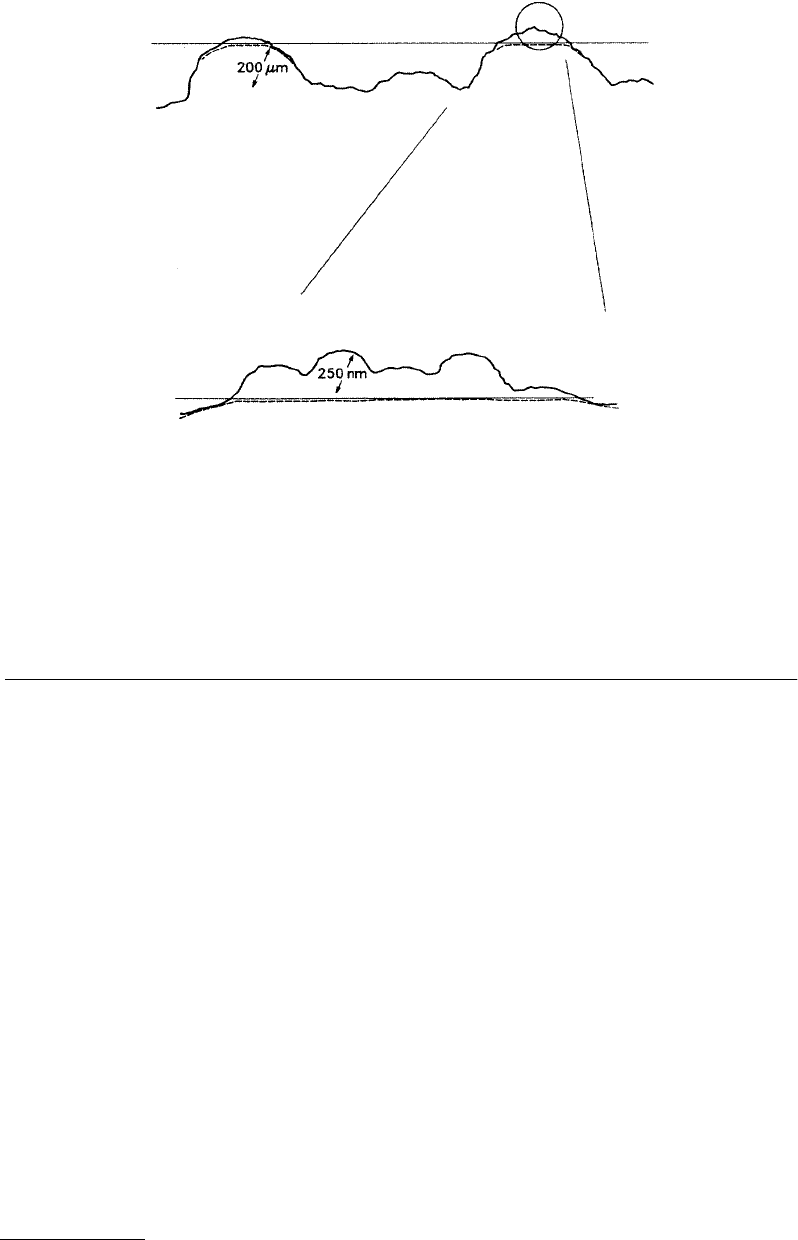
© 1999 by CRC Press LLC
Majumdar and Bhushan (1991) and Bhushan and Majumdar (1992) have reported relationships for
cumulative size distribution of the contact spots, portions of the real area of contact in elastic and plastic
deformation modes, and the load–area relationships.
14.4 Friction and Adhesion
14.4.1 Nanoscale Friction
Ruan and Bhushan (1994b) measured friction on the nanoscale using FFM. They reported that atomic-
scale friction of a freshly cleaved, highly oriented pyrolytic graphite (HOPG) exhibited the same period-
icity as that of corresponding topography (also see Mate et al., 1987), Figure 14.8. However, the peaks in
friction and those in corresponding topography profiles were displaced relative to each other, Figure 14.9.
Using Fourier expansion of the interaction potential, they calculated interatomic forces between the FFM
tip and the graphite surface. They have shown that variations in atomic-scale lateral force and the observed
displacement can be explained by the variations in intrinsic interatomic forces in the normal and lateral
directions.
14.4.2 Microscale Friction and Adhesion
Friction and adhesion of magnetic head sliders, magnetic media, virgin, treated and coated Si(111) wafers,
and graphite on a microscale have been measured by Kaneko et al. (1988, 1991a), Miyamoto et al. (1990,
1991a,c), Mate (1993a,b), Bhushan et al. (1994a–c,e, 1995a–g, 1997c, 1998), Ruan and Bhushan
(1994a–c), Koinkar and Bhushan (1996a,b, 1997a,b), and Sundararajan and Bhushan (1998).
Koinkar and Bhushan (1996a,b) and Poon and Bhushan (1995a,b) reported that rms roughness and
friction force increase with an increase in scan size at a given scanning velocity and normal force.
Therefore, it is important that while reporting friction force values, scan sizes and scanning velocity
should be mentioned. Bhushan and Sundararajan (1998) reported that friction and adhesion forces are
a function of tip radius and relative humidity (also see Koinkar and Bhushan, 1996b). Therefore, relative
FIGURE 14.7
Schematic of local asperity deformation during contact of a rough surface, upper profile measured
by an optical profiler and lower profile measured by AFM; typical dimensions are shown for a polished thin-film
rigid disk against a flat slider surface. (From Bhushan, B. and Blackman, G.S., 1991,
ASME J. Tribol.
113, 452–458.
With permission.)

© 1999 by CRC Press LLC
FIGURE 14.8
Gray-scale plots of (a) surface topography and (b) friction force maps of a 1
70×
1 nm area of a freshly cleaved
HOPG showing the atomic-scale variation of topography and friction. Higher points are shown by lighter color. (From Ruan, J.
and Bhushan, B., 1994,
J. Appl. Phys.
76, 5022–5035. With permission.)

© 1999 by CRC Press LLC
humidity should be controlled during the experiments. Care also should be taken to ensure that tip
radius does not change during the experiments.
14.4.2.1 Head Slider Materials
Al
2
O
3
–TiC is a commonly used slider material. In order to study the friction characteristics of this two
phase material, friction of Al
2
O
3
–TiC (70/30 wt%) surface was measured. Figure 14.10 shows the surface
roughness and friction force profiles (Koinkar and Bhushan, 1996a). TiC grains have a Knoop hardness
of about 2800 kg/mm
2
, which is higher than that of Al
2
O
3
grains of about 2100 kg/mm
2
. Therefore, TiC
grains do not polish as much and result in a slightly higher elevation (about 2 to 3 nm higher than that
of Al
2
O
3
grains). Based on friction force measurements, TiC grains exhibit higher friction force than
Al
2
O
3
grains. The coefficients of friction of TiC and Al
2
O
3
grains are 0.034 and 0.026, respectively, and
the coefficient of friction of Al
2
O
3
–TiC composite is 0.03. Local variation in friction force also arises from
the scratches present on the Al
2
O
3
–TiC surface. A good correspondence between surface slope (also shown
in Figure 14.10) and friction force at scratch locations is observed. (Reasons for this correlation will be
discussed later.) Thus, local friction values of two-phase materials can be measured. Ruan and Bhushan
(1994c) reported that local variation in the coefficient of friction of cleaved HOPG was significant, which
arises from structural changes occurring during the cleaving process. The cleaved HOPG surface is largely
atomically smooth but exhibits line-shaped regions in which the coefficient of friction is more than an
order of magnitude larger. Meyer et al. (1992) and Overney et al. (1992) also used FFM to measure
structural variations of a composite surface. They measured friction distribution of mixed monolayer
films produced by dipping into a solution of hydrocarbon and fluorocarbon molecules. The resulting
film consists of discrete islands of hydrocarbon in a sea of fluorocarbon. They reported that FFM can be
used to image and identify compositional domains with a resolution of ~0.5 nm. These measurements
suggest that friction measurements can be used for structural mapping of the surfaces. FFM measurements
can also be used to map chemical variations, as indicated by the use of the FFM with a modified FFM
tip to map the spatial arrangement of chemical functional groups in mixed monolayer films (Frisbie
et al., 1994). Here, sample regions that had stronger interactions with the functionalized FFM tip exhibited
larger friction.
Surface roughness and coefficient of friction of various head slider materials were measured by Koinkar
and Bhushan (1996a). For typical values, see Table 14.2. Macroscale friction values for all samples are
higher than microscale friction values; the reasons are presented in the following subsection.
FIGURE 14.9 Schematic of surface topography and fric-
tion force maps shown in Figure 14.8. The oblate triangles
and circles correspond to maxima of topography and fric-
tion force, respectively. There is a spatial shift between the
two. (From Ruan, J. and Bhushan, B., 1994, J. Appl. Phys.
76, 5022–5035. With permission.)

© 1999 by CRC Press LLC
Miyamoto et al. (1990) measured adhesive force of four tips made of tungsten, Al
2
O
3
–TiC, Si
3
N
4
, and
SiC tips in contact with unlubricated, polished SiO
2
-coated thin-film rigid disk and a disk lubricated
with 2-nm functional lubricant (with hydroxyl end groups, Z-Dol). Nominal radii for all tips were about
5 µm. Adhesive force data are presented in Table 14.3. Mean adhesive forces of the tungsten, Al
2
O
3
–TiC,
Si
3
N
4
, and SiC tips on a disk medium coated with the functional lubricant are about 10% of those for
an unlubricated disk surface. The adhesive force of the ceramic tips is lower than that for the tungsten
tip. The adhesive forces of the SiC tip show very low values, even for an unlubricated disk. A good
correlation was found between adhesive forces measured by the AFM and the coefficient of macroscale
static friction. They also reported that adhesive force increased almost linearly with an increase in the
tip radius. (Also see Sugawara et al., 1993; Bhushan et al., 1998).
14.4.2.2 Magnetic Media
Bhushan and co-workers measured friction properties of magnetic media including polished and textured
thin-film rigid disks, MP, BaFe and ME tapes, and PET tape substrate. For typical values of coefficients
of friction of polished and textured, thin-film rigid disks and MP, BaFe and ME tapes, PET tape substrate,
see Table 14.4. In the case of magnetic disks, similar coefficients of friction are observed for both lubricated
and unlubricated disks, indicating that most of the lubricant (although partially thermally bonded) is
squeezed out from between the rubbing surfaces at high interface pressures, consistent with liquids being
poor boundary lubricant (Bowden and Tabor, 1950). Coefficient of friction values on a microscale are
much lower than those on the macroscale. When measured for the small contact areas and very low loads
used in microscale studies, indentation hardness and modulus of elasticity are higher than at the mac-
roscale (data to be presented later). This reduces the real area of contact and the degree of wear. In
addition, the small apparent areas of contact reduces the number of particles trapped at the interface,
and thus minimizes the “plowing” contribution to the friction force (Bhushan et al., 1995d,f).
Miyamoto et al. (1991b) reported the coefficient of friction of an unlubricated disk with amorphous
carbon and SiO
2
overcoats against the diamond tip to be 0.24 and 0.36, respectively. The coefficients of
friction of disks lubricated with 2-nm-thick perfluoropolyether lubricant films were 0.08 for functional
lubricant (with hydroxyl end groups, Z-Dol) on SiO
2
overcoat, 0.10 for functional lubricant on carbon
overcoat, and 0.19 for nonpolar lubricant (Krytox 157FS L) on carbon overcoat. They found that the
coefficient of friction of a 4-nm-thick lubricant film was about twice that of a 2-nm-thick film. Mate
(1993a) measured the coefficient of friction of unlubricated polished and textured disks and with a
lubricant film with ester end groups (Demnum SP) against a tungsten tip with a tip radius of 100 nm.
The coefficients of friction of unlubricated polished disks and with 1.5-nm-thick lubricant film were
0.5 and 0.4, respectively, and of unlubricated textured disks and with 2.5-nm-thick lubricant film were
0.5 and 0.2, respectively.
Coefficient of microscale friction values reported by Miyamoto et al. (1991b), by Mate (1993a) and
by Bhushan et al. (1995g) (to be reported later in this section) are larger than those reported by Bhushan
et al. (1994a–c,e, 1995a–f, 1997c) in Table 14.4. Miyamoto et al. made measurements with a three-sided
pyramidal diamond tip at large loads of 500 nN to tens of micronewtons and Mate et al. made measure-
ments with a soft tungsten tip from 30 to 300 nN, as compared to Bhushan et al.’s measurements made
using the Si
3
N
4
tip at lower loads ranging from 10 to 150 nN. High values reported by Miyamoto et al.
and Mate et al. may arise from plowing contribution at higher normal loads and differences in the friction
properties of different tip materials. Bhushan et al. (1995f) have reported that the coefficient of friction
on microscale is a strong function of normal load. The critical load at which an increase in friction occurs
corresponds to surface hardness. At high loads, the coefficient of friction on microscale increases toward
values comparable with those obtained from macroscale measurements. The increase in the value of
microscale friction at higher loads is associated with interface damage and associated plowing.
In order to elegantly show any correlation between local values of friction and surface roughness,
Bhushan (1995b) measured the surface roughness and friction force of a gold-coated ruling with rect-
angular girds. Figure 14.11 shows the surface roughness profile, the slopes of roughness profile taken
along the sliding direction, and the friction force profile for the ruling. We note that friction force changes
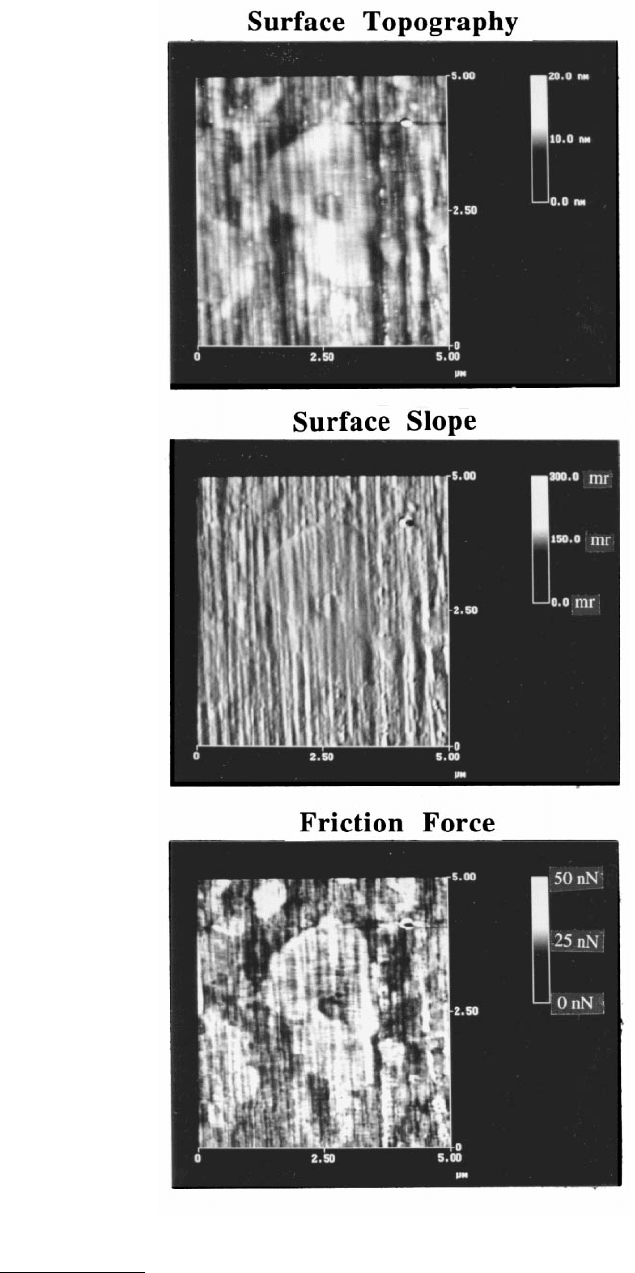
© 1999 by CRC Press LLC

© 1999 by CRC Press LLC
significantly at the edges of the grid. Friction force is high locally at the edge of grid with a positive slope
and is low at the edge of the grid with a negative slope. Thus, there is a strong correlation between the
slope of the roughness profiles and the corresponding friction force profiles.
Bhushan et al. (1994c,e, 1995a–f, 1997c) examined the relationship between local variations in micros-
cale friction force and surface roughness profiles for magnetic media. Figures 14.12 and 14.14 show the
surface roughness map, the slopes of roughness profile taken along the sliding direction, and the friction
force map for textured and lubricated disks, and an MP tape, respectively. Bhushan and Ruan (1994a)
noted that there is no resemblance between the friction force maps and the corresponding roughness
maps; e.g., high or low points on the friction force map do not correspond to high or low points on the
roughness map. By comparing the slope of roughness profiles taken in the tip sliding direction and
friction force map, we observe a strong correlation between the two. (For a clearer correlation, see gray-
scale plots of surface roughness slope and friction force profiles for FFM tip sliding in either directions
in Figures 14.13 and 14.15).
TABLE 14.2 Surface Roughness (σ and P-V distance), Micro- and Macroscale Friction, Microscratching/Wear, and
Nano- and Microhardness Data for Various Samples
Surface Roughness
nm (1 × 1 µm)
Coefficient of friction
Scratch Depth
at 60 µN (nm)
Wear Depth at
60 µN (nm)
Hardness (GPa)
Macroscale
b
Nano at
2 mN MicroSample σ P-V
a
Microscale Initial Final
Al
2
O
3
0.97 9.9 0.03 0.18 0.2–0.6 3.2 3.7 24.8 15.0
Al
2
O
3
–TiC 0.80 9.1 0.05 0.24 0.2–0.6 2.8 22.0 23.6 20.2
Polycrystalline 2.4 20.0 0.04 0.27 0.24–0.4 9.6 83.6 9.6 5.6
Mn–Zn ferrite
Single–crystal (110) 1.9 13.7 0.02 0.16 0.18–0.24 9.0 56.0 9.8 5.6
Mn–Zn ferrite
SiC (α-type) 0.91 7.2 0.02 0.29 0.18–0.24 0.4 7.7 26.7 21.8
a
Peak-to-valley distance.
b
Obtained using silicon nitride ball with 3 mm diameter in a reciprocating mode at a normal load of 10 mN, reciprocating
amplitude of 7 mm, and average sliding speed of 1 mm/s. Initial coefficient of friction values were obtained at first cycle (0.007 m
sliding distance) and final values at a sliding distance of 5 m.
TABLE 14.3 Mean Values and Ranges of Adhesive Forces
between Unlubricated and Lubricated SiO
2
-Coated Disks
and Tips Made of Various Materials
Tip Material
Adhesive Force (µN)
Without Lubricant
Functional Liquid Lubricant
(2.0 nm)
Tungsten 12.1 (2.32–13.9) 1.09 (0.67–1.60)
Al
2
O
3
–TiC 5.17 (3.64–6.92) 0.25 (0.078–0.47)
Si
3
N
4
1.88 (1.00–2.82) 0.07 (0–0.16)
SiC 0.21 (0.13–0.32) 0.030 (0–0.09)
From Miyamoto, T. et al., 1990, ASME J. Tribol. 112, 567–572. With
permission.
FIGURE 14.10 Gray-scale plots of surface topography (σ = 1.12 nm), slope of the roughness profiles taken along
the sliding direction (the horizontal axis) (mean = –0.003, σ = 0.015), and friction force map (mean = 28.5 nN, σ =
4.0 nN; Al
2
O
3
grains: mean = 24.8 mN, σ = 1.85 nN and TiC grains: mean = 32.7 nN, σ = 2.6 nN) for a Al
2
O
3
–TiC
slider for a normal load of 950 nN.

© 1999 by CRC Press LLC
To further verify the relationship between surface roughness slope and friction force values, to eliminate
any effect resulting from nonuniform composition of disk and tape surfaces, Bhushan and Ruan (1994a)
measured a polished natural (IIa) diamond. Repeated measurements were made along one line on the
surface. Highly reproducible data were obtained, Figure 14.16. Again, the variation of friction force
correlates to the variation of the slope of the roughness profiles taken along the sliding direction of the
tip. This correlation has been shown to hold for various magnetic disks, magnetic tapes, polyester tape
substrates, silicon, graphite and other materials (Bhushan et al., 1994a,c–e, 1995a–d, 1997a, 1998; Ruan
and Bhushan, 1994b,c).
We now examine the mechanism of microscale friction, which may explain the resemblance between
the slope of surface roughness profiles and the corresponding friction force profiles (Bhushan and Ruan,
1994a; Ruan and Bhushan, 1994b,c). There are three dominant mechanisms of friction: adhesive, adhesive
and roughness (ratchet), and plowing. As a first order, we may assume these to be additive. The adhesive
mechanism alone cannot explain the local variation in friction. Let us consider the ratchet mechanism.
According to Makinson (1948), we consider a small tip sliding over an asperity making an angle θ with
the horizontal plane, Figure 14.17. The normal force (normal to the general surface) applied by the tip
to the sample surface W is constant. Friction force F on the sample varies as a function of the surface
roughness. It would be a constant µ
0
W for a smooth surface in the presence of “adhesive” friction
mechanism. In the presence of a surface asperity, the local coefficient of friction µ
1
in the ascending part is
(14.3)
Since µ
0
tan θ is small on a microscale, Equation 14.3 can be rewritten as
(14.4)
indicating that in the ascending part of the asperity one may simply add the friction force and the asperity
slope to one another. Similarly, on the right-hand side (descending part) of the asperity,
TABLE 14.4 Surface Roughness (σ), Microscale and Macroscale Friction, and Nanohardness Data of Thin-Film
Magnetic Rigid Disk, Magnetic Tape, and Magnetic Tape Substrate (PET) Samples
Sample
σ (nm)
Coefficient of
Microscale Friction
Coefficient of
Macroscale Friction
Nanohardness
(GPa)/
Normal Load
(µN)
NOP
AFM
250 × 250 µm
a
1 × 1 µm
a
10 × 10 µm
a
1 × 1 µm
a
10 × 10 µm
a
Mn–Zn
Al
2
O
3
–TiCFerrite
Polished,
unlubricated
disk
2.2 3.3 4.5 0.05 0.06 — 0.26 21/100
Polished,
lubricated disk
2.3 2.3 4.1 0.04 0.05 — 0.19 —
Textured,
lubricated disk
4.6 5.4 8.7 0.04 0.05 — 0.16 —
MP tape 6.0 5.1 12.5 0.08 0.06 0.19 — 0.30/50
Barium-ferrite
tape
12.3 7.0 7.9 0.07 0.03 0.18 — 0.25/25
ME tape 9.3 4.7 5.1 0.05 0.03 0.18 — 0.7 to 4.3/75
PET tape
substrate
33 5.8 7.0 0.05 0.04 0.55 — 0.3/20 and
1.4/20
b
a
Scan area; NOP = noncontact optical profiler; AFM = atomic force microscope.
b
Numbers are for polymer and particulate regions, respectively.
µ= =µ+
()
−µ
()
10 0
1FW tan tan .θθ
µµ+
10
~ tan ,θ
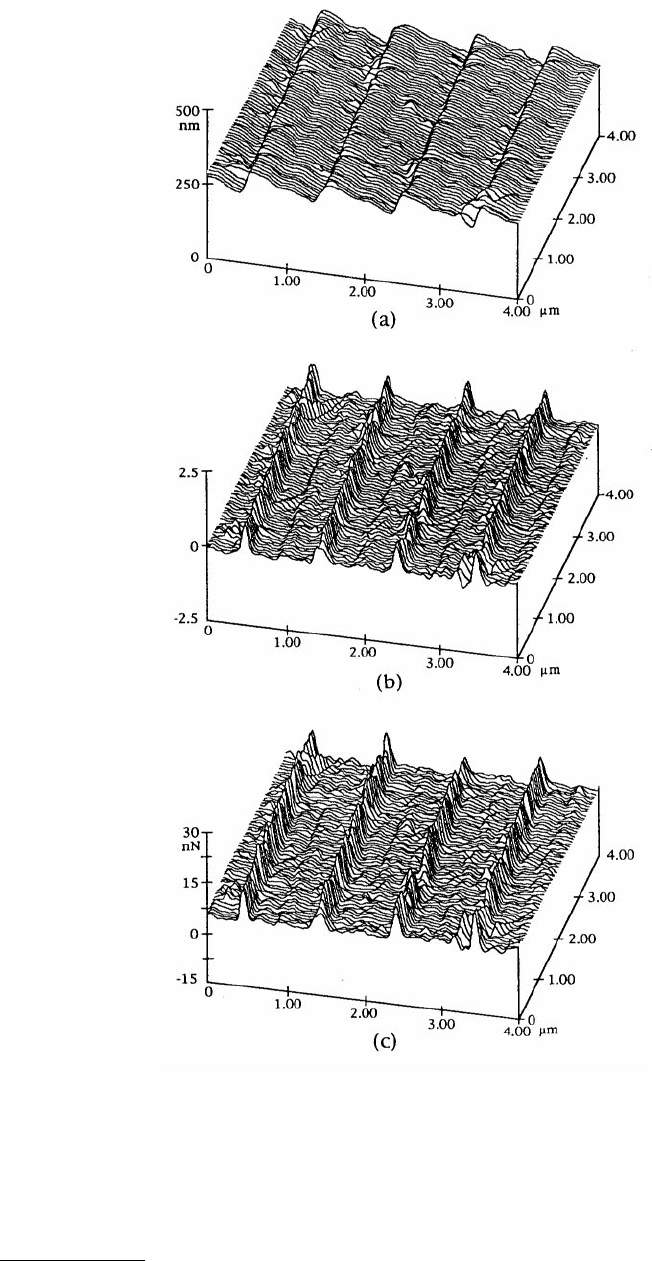
© 1999 by CRC Press LLC
FIGURE 14.11 (a) Surface roughness map, (b) slope of the roughness profiles taken in the sample sliding direction
(the horizontal axis), and (c) friction force map for a gold-coated ruling at a normal load of 155 nN. (From Bhushan,
B., 1995, Tribol. Int. 28, 85–95. With permission.)
